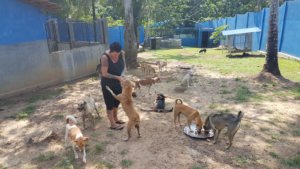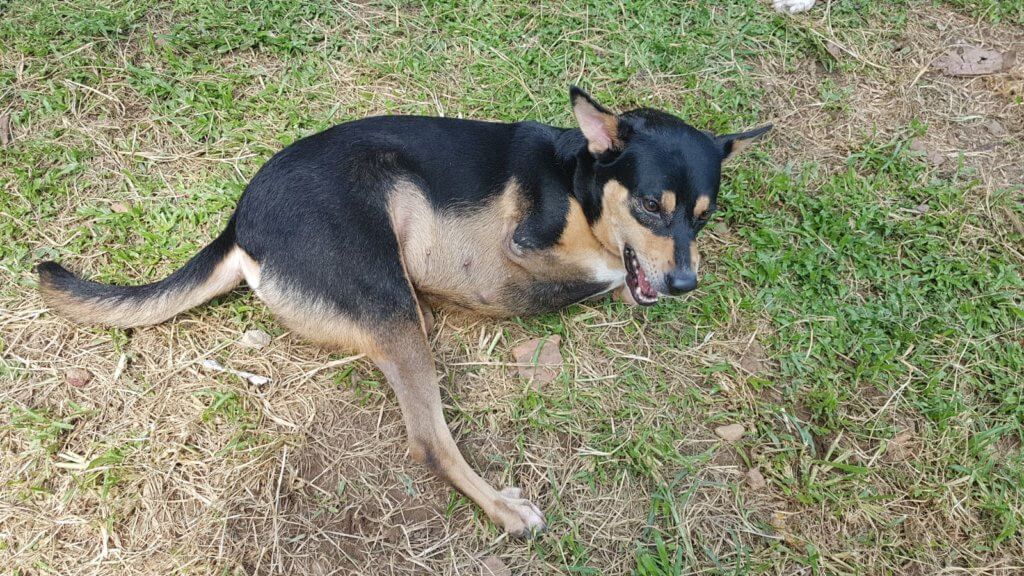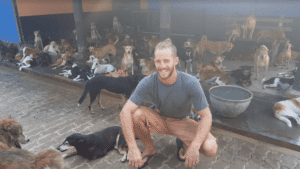Guest Post By Phillip Krynski from Tallala Retreat.
The pale-blue iron gates fling open and my gaze pans across a sea of puppy dog eyes. The chorus of barking is instantaneous and bellowing. Hundreds of dogs come bounding over to see who the new visitors are. Luxembourgish dog trainer Aimee Frieden and I stand our ground whilst wondering how so many dogs in one place get along and whether in the excitement, they would attack humans. If they do attack, will every dog in the yard join the scrap? I notice each individual dog and realise that they are only being stimulated by new faces with no intention of attacking. Bending down, I scratch one of them behind the ears and see his calm nature. In fact – I see all of their calm natures. That’s because the 1,300 furry guests of the Sri Lankan Animal SOS shelter, are treated with love, kindness and care every day. And with so many dogs, the organisation is now in dire need of an expansion, but lacks the essential funds for development.

The donation-run animal rehabilitation centre was opened in 2009 by Kim Cooling from the UK after she was touched by the plight of over 3 million street dogs in Sri Lanka. Animal SOS cares for over 1,200 dogs and 100 cats across 4 acres. “The aim of having a sanctuary is to give refuge to some dogs that really can’t survive on the streets” says Kim in a recent mini-doco filmed by Animal 360 called Animal SOS Sri Lanka: Survival. Most of these street animals (a small amount owned) come in with an illness or disability. Worker and Spanish expat Aritz explains that the centre feeds 360 kg of rice, fish and vegetables to the shelter’s hungry guests every day. Whilst watching during feeding time, dog trainer Aimee wide-eyedly declares “I’m amazed that there is such a large concentration of dogs, but so little aggression and fighting. They are doing an amazing job”. Many of the dogs have been run over by cars and have broken their back legs as a result of not running away fast enough. One scruffy, but happy looking fella dubbed Teddy Bear hurriedly tucks into his chow. A worker explains that Teddy Bear was a street dog who had been hit by a car 4 times on the day he was brought in to Animal SOS. Thanks to the hard-working staff, he is now back on four feet and jumping around the yard.

General Manager Marie
There are currently 5 expats, 2 vets and 33 local staff members running the shelter. They have named every one of the 1,200 dogs and remember many of them (understandably reverting to a photo database for ones they forget). It seems like the staff have fun naming the new arrivals who come in. Within a litter of jet-black puppies, each is named after one the Teletubbies. Another pack in the yard is named after each of the planets, with the mother being called ‘Galaxy’.
I spot a female worker at the bottom of the hill, standing by a noticeably docile dog. Down the hill I stroll to strike up a conversation with the Norwegian general manager Marie. She introduces me to Kalu the one-legged dog, who is lying on the floor below us. To my amazement, I see a beautiful bi-coloured dog with only one leg, grazing on her lunch. I’ve seen a three-legged dog, even a two-legged dog, but never a one-legged dog. She seems so helpless, but reassuringly happy. Marie continues to explain that Kalu was a heavily pregnant family dog and fell asleep in a field, she was then run over by a rice harvester. The frantic family brought her straight to Animal SOS, where they were able to save her life and are still in the process of rehabilitating her. Sadly, all her pups had died at the time of the accident. As we tour the grounds, I realise that every single dog in the shelter has come from a story, many times a horrible one. Though now, they are in safe and caring hands.

Although there are many dogs freely roaming the yard, a number are held in small enclosures. I walk through the enclosure and discover that many of their legs are severely damaged, and that these are the disabled dogs who need serious attention. They have specially-designed wheelchairs in which they receive daily walks for up to an hour. The recovering dogs look like little Roman chariots when they trot about attached to their bionic wheels. Another of the workers explains to me that they have 4 acres of occupied land and some adjacent 1.5 acres of land was donated 2 years back. The plan is to build a fully equipped disability centre for the influx of injured dogs they must rehabilitate. The only issue is, Animal SOS are significantly stretched for funds and they are reaching out to afford the development.

To help raise the £300,000 for this wonderful project please feel free to donate on the Animal SOS website. Animal SOS survives on donations and founder Kim Cooling says, “We’ve hardly got any funds and we’re hand to mouth every single month”. The centre also welcomes visitors between 10am-2pm if you are interested in meeting a team of amazing people and inspiring dogs.
Animal SOS achievements of 2017
> They provided over 17,500 treatments for diseases, wounds, fractures and tumors.
> They sterilized 1,255 dogs and cats and conducted 850 surgeries for other conditions.
> They conducted over 7,500 blood tests/smears/chemistry/ hematology and 4,500 other tests – skin scrapes, parvovirus and distemper tests.
> They provided over 6,500 vaccinations against rabies and other dangerous viruses.
> They provided over 15,000 anti-parasitic treatments.
> They conduct weekly outreach programs in local villages – treating, sterilizing and vaccinating cats and dogs.
> They are operational EVERY day.
>They feed over 1300 cats and dogs a day
I want to say a big thank you to Phillip for showing such a caring attitude to such a beautiful charity and for allowing me to post his article to help spread the word. Please follow Animal SOS on their social media:
Thanks for reading!
Please leave a comment about anything you read, or if need any advice. I would love to hear from you.
Leave a Reply